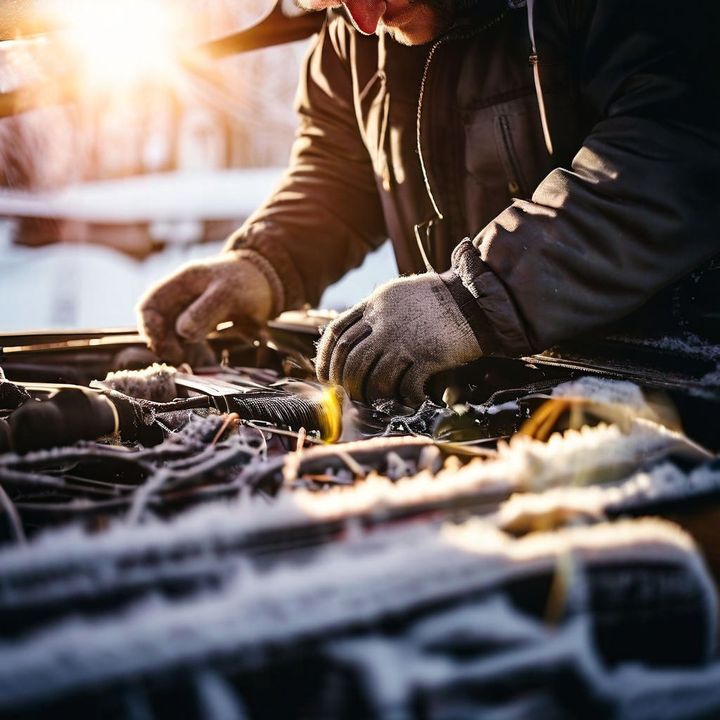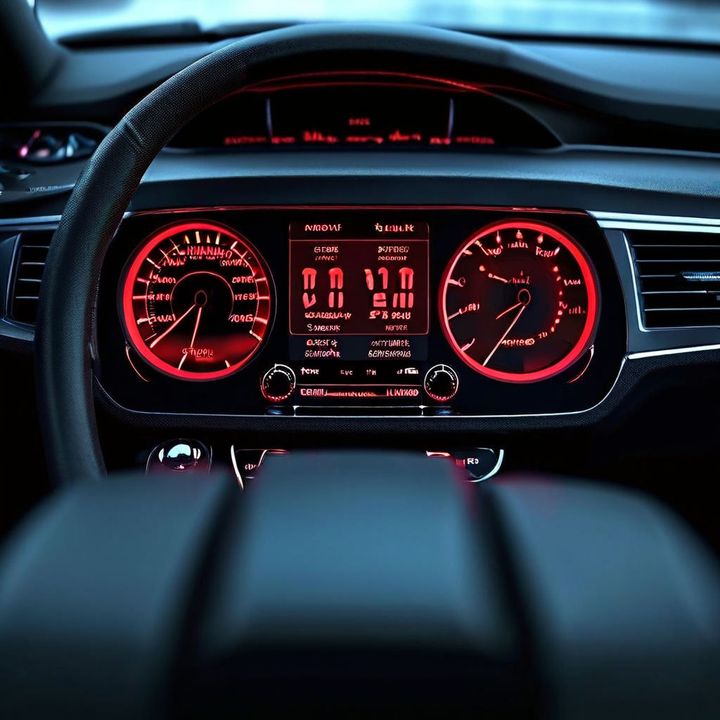


A car's heating system is designed to provide warmth and comfort to the cabin during cold weather conditions. However, it's not uncommon for drivers to experience issues where the heater blows cold air while the vehicle is idling. This problem can be frustrating and potentially dangerous, as it can lead to poor visibility due to fogged windows and an uncomfortable driving experience. Understanding the causes and potential solutions for this issue is crucial for maintaining a properly functioning heating system.

Before we dive into the nitty-gritty of the problem, let's take a moment to understand how your car's heating system works. At the heart of it all lies the heater core, a small radiator-like component that relies on hot coolant from the engine's cooling system to produce warm air.
| Component | Function |
|---|---|
| Heater Core | Transfers heat from the coolant to the air blown into the cabin |
| Coolant | Circulates through the engine and heater core, carrying heat |
| Thermostat | Regulates the flow and temperature of the coolant |
| Water Pump | Circulates the coolant throughout the cooling system |
| Blend Door Actuator | Controls the mixture of hot and cold air entering the cabin |
When everything is functioning correctly, the coolant circulates through the heater core, transferring its heat to the air that's then blown into the cabin by the blower motor and fan.
Now, let's explore the most common culprits behind your car heater blowing cold air while idling:
If the coolant level in your engine's cooling system is low, there simply won't be enough hot liquid flowing through the heater core to warm the air effectively. This can be caused by a leak in the system or a lack of proper maintenance.
Common symptoms:
Heater blowing cold air, especially at idle
Low coolant level in the overflow tank
Coolant leak under the vehicle or engine bay
The thermostat is a crucial component that regulates the flow of coolant in the engine's cooling system. If it's stuck open or malfunctioning, it can prevent the coolant from reaching the optimal temperature required for efficient heating.
Common symptoms:
Heater blowing cold air, even after the engine has warmed up
Engine temperature gauge reading lower than normal
Coolant not circulating properly
Over time, the heater core can become clogged with debris, contaminants, and even rust, restricting the flow of coolant and preventing it from heating up properly. This is often accompanied by a sweet odor or fog in the cabin.
Common symptoms:
Heater blowing cold air, even with a hot engine
Sweet odor or fog in the cabin
Reduced airflow from the vents
Air trapped in the cooling system can disrupt the flow of coolant to the heater core, leading to cold air at idle. This can happen after certain repairs or if the system hasn't been properly bled.
Common symptoms:
Heater blowing cold air, especially at idle
Coolant level fluctuating or dropping
Gurgling noises from the cooling system
The water pump is responsible for circulating the coolant throughout the engine's cooling system. If it's failing, it may not be able to circulate the coolant effectively, especially at lower RPMs, resulting in cold air from the heater when idling.
Common symptoms:
Heater blowing cold air, especially at idle
Coolant leaks around the water pump
Whining or grinding noises from the water pump
The blend door actuator controls the mixture of hot and cold air entering the cabin. If it's stuck or malfunctioning, it may prevent hot air from reaching the vents, even if the heater core is working correctly.
Common symptoms:
Heater blowing cold air, even with a hot engine
Inconsistent temperature distribution from the vents
Clicking or grinding noises from the actuator
Now that we've covered the potential causes, let's dive into the troubleshooting and diagnosis process:
Check the coolant level: This is the first and most straightforward step. If the coolant level is low, top it up and look for any leaks in the cooling system.
Look for signs of a clogged heater core: If you notice a sweet odor or fog in the cabin, it could be an indication that your heater core is clogged and needs attention.
Check the blend door actuator: Inspect the blend door actuator for proper operation and any obstructions that may be preventing hot air from entering the cabin.
Bleed the cooling system: Air pockets in the cooling system can be a sneaky culprit. Bleed the system by running the engine with the radiator cap off until the coolant level stabilizes and all air bubbles are purged.
Once you've identified the root cause of your car heater blowing cold air while idling, it's time to roll up your sleeves and get to work. Here are the repair instructions for each potential issue:
If the problem is simply a low coolant level, the solution is straightforward: top up the coolant and repair any leaks in the cooling system. This may involve replacing hoses, gaskets, or other components as needed.
If the thermostat is the culprit, you'll need to replace it following the manufacturer's instructions. This typically involves:
Draining a portion of the coolant
Removing the old thermostat
Installing a new thermostat
Refilling the cooling system with fresh coolant
A clogged heater core can be a bit more challenging to address. You may need to flush the heater core using a chemical cleaner or backflush it to remove any debris or contaminants. In severe cases, the heater core may need to be replaced entirely, which can be a labor-intensive process.
To remove air pockets from the cooling system, you'll need to bleed the system by running the engine with the radiator cap off until all air bubbles are purged and the coolant level stabilizes.
If the water pump is the culprit, you'll need to replace it according to the manufacturer's guidelines. This typically involves:
Draining the coolant
Removing the old water pump
Installing a new water pump
Replacing any necessary gaskets or seals
Refilling the cooling system with fresh coolant
If the blend door actuator is stuck or malfunctioning, you may need to repair or replace it as needed. This can involve:

Disassembling the HVAC system to access the actuator
Cleaning or replacing the actuator
Reassembling the HVAC system
While repairs are sometimes necessary, prevention is always better than cure. Here are some preventive measures you can take to keep your car's heating system in top shape:
Use high-quality coolant: Always use high-quality coolant recommended by your vehicle's manufacturer, and avoid mixing different types of coolant.
Proper bleeding after repairs or maintenance: Ensure that the cooling system is properly bled after any repairs or maintenance to prevent air pockets from forming.
Prompt replacement of worn components: Inspect and replace worn or damaged cooling system components promptly to prevent further issues from arising.
Regular inspections: Have your car's heating system inspected by a professional mechanic during routine maintenance to catch any potential issues early on.
Now, let's address the elephant in the room: the cost of repairs. The truth is, the cost can vary significantly depending on the specific issue and the make and model of your vehicle. However, here are some approximate cost ranges to give you an idea:
| Repair | Cost Range |
|---|---|
| Coolant top-up or leak repair | $50 - $200 |
| Thermostat replacement | $150 - $300 |
| Heater core flush or replacement | $300 - $800 |
| Water pump replacement | $400 - $800 |
| Blend door actuator repair or replacement | $200 - $500 |
Keep in mind that these are rough estimates, and the actual cost may vary based on your location, the complexity of the repair, and labor rates at your chosen repair facility. It's always recommended to get a quote from a reputable mechanic before proceeding with any repairs.
Dealing with a car heater that's blowing cold air while idling can be a frustrating experience, but with the right knowledge and approach, it's a problem that can be solved. By understanding the potential causes, following the troubleshooting steps, and implementing the appropriate repair solutions, you can get your car's heating system back in top shape and enjoy a warm, cozy ride, even on the chilliest of days.
Remember, preventive maintenance is key to avoiding these issues in the first place. Regular coolant checks, high-quality coolant, and prompt replacement of worn components can go a long way in keeping your car's heating system running smoothly.
So, the next time you find yourself shivering in your car while idling, don't panic. Take a deep breath, and follow the guidance I've provided. With a little elbow grease and the right approach, you'll be basking in the warmth of your car's heater in no time.
Happy motoring, my friends!
First, check the coolant level and top it up if low. If that doesn't work, you may need to get the heating system components inspected by a mechanic.
Yes, a stuck-open or malfunctioning thermostat can prevent the coolant from reaching the optimal temperature required for the heater to work properly.
Signs of a clogged heater core include a sweet odor or fog in the cabin, excessive coolant consumption, and the engine overheating.
Air pockets can form due to low coolant levels or a faulty radiator cap, disrupting the flow of coolant to the heater core.
Yes, if the blend door actuator is stuck or malfunctioning, it may prevent hot air from reaching the vents, even if the heater core is working correctly.
It's recommended to flush the heater core periodically as part of regular maintenance to remove any debris or contaminants that may have accumulated.
Yes, a leaking water pump can disrupt the circulation of coolant, preventing it from reaching the heater core and causing the heater to blow cold air.
This could be caused by air pockets or a thermostat issue. You should have the cooling system inspected and potentially bled or have the thermostat replaced.
The cost can vary depending on the specific issue, but on average, a car heater repair can range from $150 to $800.
Yes, if left unaddressed, low coolant levels can lead to overheating and potentially cause severe engine damage.

Sarah isn't your average gearhead. With a double major in Mechanical Engineering and Automotive Technology, she dived straight into the world of car repair. After 15 years of turning wrenches at dealerships and independent shops, Sarah joined MICDOT to share her expertise and passion for making cars run like new. Her in-depth knowledge and knack for explaining complex issues in simple terms make her a valuable asset to our team.













